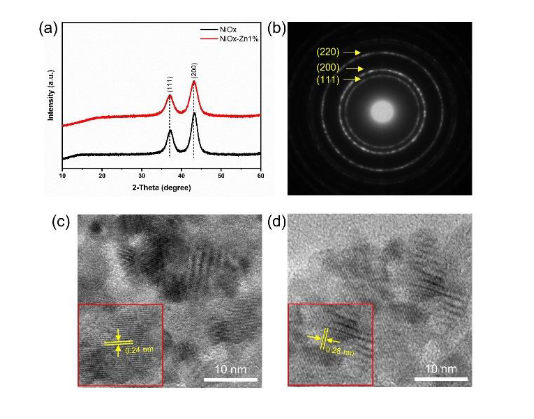Utilization of Zinc-doped Nickel Oxide Hole Transporting Materials to Improve Efficiency and Stability of Perovskite Solar Cells
DOI:
https://doi.org/10.53848/ssstj.v9i2.236Keywords:
Perovskite solar cells, Doping, NiOx, Zn, Hole transporting layersAbstract
Currently, several techniques have been employed in order to obtain a better quality of perovskite solar cells (PSCs). In this research, we focus on the development of the hole transporting material (HTM) for the efficiency as well as the stability enhancement of the PSCs. Here, a hole transporting layer (HTL) was fabricated using zincdoped nickel oxide (Zn-doped NiOx) nanoparticles and the HTL was incorporated into the cesium-formamidinium (CsFA) based PSCs to improve the electrical properties. As a result, PSCs with 1% Zn-doped NiOx demonstrated the highest power conversion efficiency (PCE) up to 14.72% with an open-circuit voltage (VOC), a short-circuit current density (JSC) and a fill factor of 1.02 V, 19.59 mA/cm2 and 0.734, respectively. Moreover, the PSCs with Zn-doped NiOx showed an enhancement in shelf-stability under aging conditions. The physical properties of the Zn-doped NiOx were analyzed using X-ray photoelectron spectroscopy (XPS) and transmission electron microscopy (TEM). The morphological characteristics of the HTL surface were examined by scanning electron microscopy (SEM) and the photovoltaic properties were analyzed in more detail.
References
Cao, J., Yu, H., Zhou, S., Qin, M., Lau, T. K., Lu, X., … Wong, C. P. (2017). Low-temperature solution-processed NiOX films for air-stable perovskite solar cells. Journal of Materials Chemistry A, 5(22), 11071-11077. doi:10.1039/c7ta02228j
Chakrabarti, S., Carolan, D., Alessi, B., Maguire, P., Svrcek, V., & Mariotti, D. (2019). Microplasma-synthesized ultra-small NiO nanocrystals, a ubiquitous hole transport material. Nanoscale Advances, 1, 4915-4925. doi:10.1039/c9na00299e
Er, U., Icli, K. C., & Ozenbas, M. (2020). Spin-coated copper(I) thiocyanate as a hole transport layer for perovskite solar cells. Journal of Solid State Electrochemistry, 24, 293-304. doi:10.1007/s10008-019-04430-2
Jeon, N. J., Na, H., Jung, E. H., Yang, T. Y. Lee, Y. G., Kim, G., … Seo, J. (2018). A fluorene-terminated hole-transporting material for highly efficient and stable perovskite solar cells. Nature Energy, 3, 682-689. doi:10.1038/s41560-018-0200-6
Kim, J., Lee, Y., Gil, B., Yun, A. J., Kim, J., Woo, H., … Park, B. (2020). A Cu2O-CuSCN nanocomposite as a hole-transport material of perovskite solar cells for enhanced carrier transport and suppressed interfacial degradation. ACS Applied Energy Materials, 3, 7572-7579. doi:10.1021/acsaem.0c01001
Koshtyal, Y., Nazarov, D., Ezhov, I., Mitrofanov, I., Kim, A., Rymyantsev, A., … Maximov, M. (2019). Atomic layer deposition of NiO to produce active material for thin-film lithiumion batteries. Coatings, 9(5), 301. doi:10.3390/coatings9050301
Mahmud Hasan, A. K., Raifuku, I., Amin, N., Ishikawa, Y., Sarkar, D. K., Sobayel, K., … Akhtaruzzaman, M. (2020). Air-stable perovskite photovoltaic cells with low temperature deposited NiOx as an efficient hole-transporting material. Optical Materials Express, 10(8), 1801-1816. doi:10.1364/ome.391321
Meng, L., You, J., & Yang, Y. (2018). Addressing the stability issue of perovskite solar cells for commercial applications. Nature Communications, 9, 5265. doi:10.1038/s41467-018-07255-1
Miyata, A., Mitioglu, A., Plochocka, P., Portugall, O., Wang, J. T. W., Stranks, S. D., … Nicholas, R. J. (2015). Direct measurement of the exciton binding energy and effective masses for charge carriers in organic-inorganic tri-halide perovskites. Nature Physics, 11, 582-587. doi:10.1038/nphys3357
Nam, V. B., Shin, J., Yoon, Y., Giang, T. T., Kwon, J., Suh, Y. D., …Lee, D. (2019). Highly stable Nibased flexible transparent conducting panels fabricated by laser digital patterning. Advanced Functional Materials, 29(8), 1806895. doi:10.1002/adfm.201806895
Passatorntaschakorn, W., Bhoomanee, C., Ruankham, P., Gardchareon, A., Songsiriritthigul, P., & Wongratanaphisan, D. (2021). Room-temperature carbon electrodes with ethanol solvent interlacing process for efficient and stable planar hybrid perovskite solar cells. Energy Reports, 7, 2493-2500. doi:10.1016/j.egyr.2021.04.031
Ratcliff, E. L., Meyer, J., Steirer, K. X., Garcia, A., Berry, J. J., Ginley, D. S., … Armstrong, N. R. (2011). Evidence for near-surface NiOOH species in solution-processed NiOx selective interlayer materials: Impact on energetics and the performance of polymer bulk heterojunction photovoltaics. Chemistry of Materials, 23, 4988-5000. doi:10.1021/cm202296p
Sahoo, S. K., Manoharan, B., & Sivakumar, N. (2018). Introduction: Why perovskite and perovskite solar cells? In S. Thomas, & A. Thankappan (Eds.), Perovskite photovoltaics (pp. 1-24). Academic Press. doi:10.1016/B978-0-12-812915-9.00001-0
Schutt, K., Nayak, P. K., Ramadan, A. J., Wenger, B., Lin, Y. H., & Snaith, H. J. (2019). Overcoming zinc oxide interface instability with a methylammonium-free perovskite for highperformance solar cells. Advanced Functional Materials, 29(47), 1900466. doi:10.1002/adfm.201900466
Serhan, M., Sprowls, M., Jackemeyer, D., Long, M., Perez, I. D., Maret, W., … Forzani, E. (2019). Total iron measurement in human serum with a smartphone. AIChE Annual Meeting, Conference Proceedings, 2019. doi:10.1039/x0xx00000x
Shahiduzzaman, M., Fukaya, S., Muslih, E. Y., Wang, L., Nakano, M., Akhtaruzzaman, M., … Taima, T. (2020). Metal oxide compact electron transport layer modification for efficient and stable perovskite solar cells. Materials, 13(9), 2207. doi:10.3390/ma13092207
Song, J. X., Yin, X. X., Li, Z. F., & Li, Y. W. (2021). Low-temperature-processed metal oxide electron transport layers for efficient planar perovskite solar cells. Rare Metals, 40, 2730-2746. doi:10.1007/s12598-020-01676-y
Xie, X., Gao, C., Du, X., Zhu, G., Xie, W., Liu, P., & Tang, Z. (2018). Improved optical and electrochromic properties of NiOx films by low-temperature spin-coating method based on NiOx nanoparticles. Materials, 11(5), 760. doi:10.3390/ma11050760
Yang, G., & Park, S. J. (2019). Conventional and microwave hydrothermal synthesis and application of functional materials: A review. Materials, 12(7), 1177. doi:10.3390/ma12071177
Yin, X., Liu, J., Ma, J., Zhang, C., Chen, P., Que, M., … Shao, J. (2016). Solvothermal derived crystalline NiOx nanoparticles for high performance perovskite solar cells. Journal of Power Sources, 329, 398-405. doi:10.1016/j.jpowsour.2016.08.102
Zhang, H., Xiao, J., Shi, J., Su, H., Luo, Y., Li, D., … Meng, Q. (2018). Self-adhesive microporous carbon electrodes for efficient and stable perovskite solar cells. Advanced Functional Materials, 28(39), 1802985. doi:10.1002/adfm.201802985
Zhao, Y., Dong, G., Duan, L., Qiao, J., Zhang, D., Wang, L., & Qiu, Y. (2012). Impacts of Sn precursors on solution-processed amorphous zinc-tin oxide films and their transistors. RSC Advances, 2, 5307-5313. doi:10.1039/c2ra00764a
Zhou, D., Zhou, T., Tian, Y., Zhu, X., & Tu, Y. (2018). Perovskite-based solar cells: Materials, methods, and future perspectives. Journal of Nanomaterials, 2018, 1-15. doi:10.1155/2018/8148072













